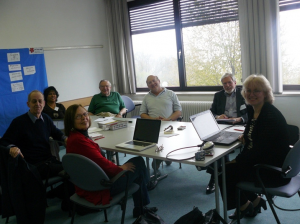International Federation for Systems Research Conversation
St. Magdalena Conference Hotel, Linz, Austria
April 14-19, 2012

Background materials
Second Order Science: Logic, Strategies, Methods (Slides)
Stuart Umpleby
Second Order Science: an Example of Emergence in Social Systems (Slides)
Helmut Loeckenhoff
Third Order Cybernetics: Biosemeosis and the Logical Contrasts between Electro-chemical and Electro-mechanical Cybernetics
Jerry LR Chandler
Cybernetics and the Russian Intellectual Tradition (Paper) (Slides)
Tatiana Medvedeva
Final Report: Science Too! The Science 2 Team: A Report from the 2012 IFSR Conversation (Paper) (Slides)
Table 1 describes the features of science 1 and science 2.
Table 2 compares the purposes and methods of science 1, science 2, and law.
Science 1 creates descriptions of how the world works.
Science 2 creates methods for acting successfully to achieve one’s purpose.
Law is a set of rules that constrain human behaviors within acceptable limits.
Table 1: Features of Science 1 and Science 2
|
Aspects
|
Science One
|
Science Two
|
|
Philosophy
|
Cause and effect
|
Producer-product
|
|
Form of knowledge
|
Theories
|
Methods
|
|
Observer
|
Outside the system observed
|
Part of the system observed
|
|
Causality
|
If-then
|
Necessary conditions
|
|
Perspective
|
Reductionism
|
Expansionism
|
|
Orientation
|
Analysis
|
Synthesis
|
|
Approach
|
Observation
|
Participation
|
|
Activity
|
Description
|
Prescription
|
|
Goal
|
Reliability of knowledge
|
Agreement or acceptance
|
|
Application
|
Forecast
|
Create or design
|
|
Criterion
|
Reproducibility
|
Usefulness
|
Table 2: The Role of Knowledge in Science 1, Science 2 and Law
|
Science One
|
Science Two
|
Law
|
|
| What is the purpose? |
The purpose is to describe how the world works.
|
The purpose is to help people work together to achieve common goals.
|
The purpose is to achieve political stability and to protect human rights.
|
| Who practises it? |
Scientists are highly educated. They have special training.
|
Managers sometimes have education in management. They need leadership skills.
|
Lawyers and legislators generally have a legal education.
|
| How is knowledge codified? |
Knowledge is codified in the form of theories.
|
Knowledge is embodied in the form of methods.
|
Experience is codified in laws and court judgments.
|
| How is knowledge developed? |
Knowledge is developed using scientific methods.
|
Knowledge is developed through experience, consulting practice.
|
Laws and precedents result from elections, legislation, and court appeals.
|
| How is knowledge passed on? |
Knowledge is preserved in scientific literature and taught in science courses.
|
Methods are learned and passed on by using them.
|
People are expected to obey laws. Laws are enforced by the police and courts.
|
| How are rules changed? |
Theories change through testing, experimentation, and invention.
|
Methods change through imitation, experimentation, and innovation.
|
Laws are changed through the legal process – elections, legislation, enforcement, court appeals.
|
| Why are ideas accepted? |
Theories are accepted as the best available explanation of observations.
|
Methods are accepted as a means to improve group performance.
|
Laws are obeyed partly out of desire for a stable society and partly out of fear of punishment.
|
| The nature of the journey. |
Theories are steps in an endless search for truth.
|
Methods aid coordination, production of goods, and conflict resolution.
|
A body of laws, precedents, and judicial interpretations assure political and social stability.
|
(from left to right: Helmut Lockenhoff, Leoni Salamans, Allenna Leonard, Jerry Chandler, Michael Lissack, Stuart Umpleby, Tatiana Medvedeva)
